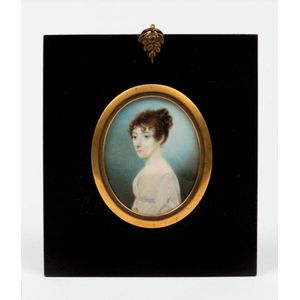Regency Lady with Lorgnette Miniature Portrait
A Regency style portrait miniature of a lady, 19th century wearing a white dress with a lorgnette on a gold chain around her neck, gilded oval slip in a later ebonised rectangular frame, inscribed verso 7.3 cm high
You must be a subscriber, and be logged in to view price and dealer details.
Subscribe Now to view actual auction price for this item
When you subscribe, you have the option of setting the currency in which to display prices to $Au, $US, $NZ or Stg.
This item has been sold, and the description, image and price are for reference purposes only.
- Verso - Verso is the "back" side of a sheet of paper, art work, coin or medal. The front side is "recto".
- Regency Period - The Regency period in English furniture design refers to the period when King George III, was declared unfit to rule in 1811, and his son ruled as proxy as Prince Regent, until 1820, and then, after the death of his father as George IV until his death in 1830. The Regency period was preceded by the Georgian period (George I, George II, and George III: 1714 - 1811), and was followed by the William IV period, which only lasted until 1837 when William IV died as was succeeded by Queen Victoria.
- Gilding - Gilding is a method of ornamentation whereby a thin sheet of gold metal is applied to items made of wood, leather, ceramics, glass and silver for decorative purposes.
For furniture including mirrors, the sheet of gold is usually applied over a coating of gesso. Gesso is a mixture of plaster of Paris and gypsum mixed with water and then applied to the carved wooden frames of mirrors and picture frames as a base for applying the gold leaf. After numerous coats of gesso have been applied, allowed to dry and then sanded a coat of "bole", a usually red coloured mixture of clay and glue is brushed on and allowed to dry, after which the gold leaf is applied. Over time parts of the gilding will rub off so the base colour can be seen. In water gilding, this was generally a blue colour, while in oil gilding, the under layer was often yellow. In Victorian times, gilders frequently used red as a pigment beneath the gold leaf.
Metal was often gilded by a process known as fire gilding. Gold mixed with mercury was applied and heated, causing the mercury to evaporate, the long-term effect of which was to kill or disable the craftsman or woman from mercury poisoning. The pursuit of beauty has claimed many victims, not the least of which were the artists who made those pieces so highly sought after today.
This item has been included into following indexes:
-
miniatures
- 19th century 338
- portrait and other 1,198
- Victorian 364
Visually similar items

Georgian framed miniature portrait on ivory. Frame 9 x 11 cm
Sold by
in
for
You can display prices in $Au, $US, $NZ or Stg.

Miniature portrait of Prince Ludwid of Prussia after Schroder, set in a timber domed glass frame. Condition good, minor wear. Length 15 cm
Sold by
in
for
You can display prices in $Au, $US, $NZ or Stg.

Portrait miniature, Beethoven, handpainted, with decorative ebonised and brass decorated frame, height 14 cm
Sold by
in
for
You can display prices in $Au, $US, $NZ or Stg.

A portrait miniature, of a young lady, painted on ivory, in ebonised timber frame
Sold by
in
for
You can display prices in $Au, $US, $NZ or Stg.
